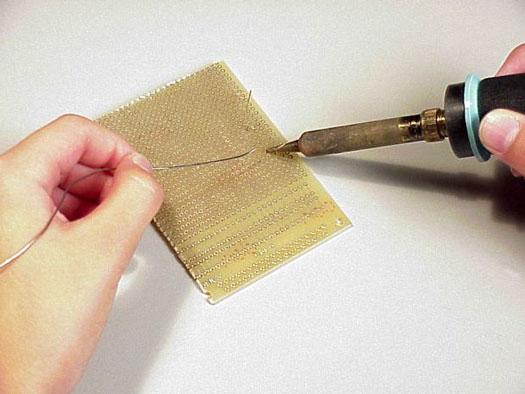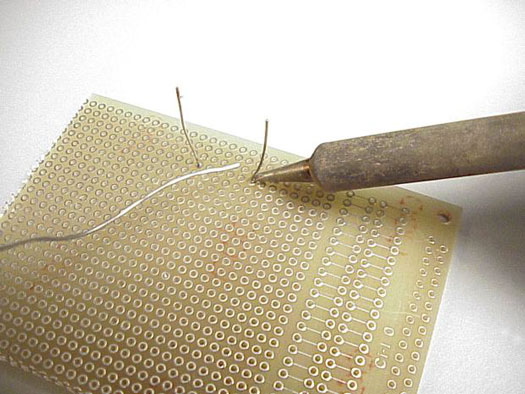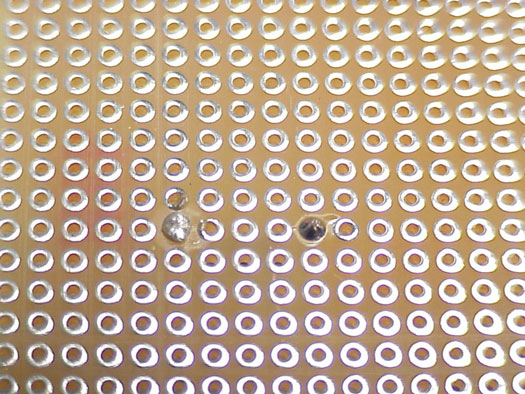Soldering (pronounced "soddering") involves a material called solder that melts when placed on a hot object; the melted solder cools and forms a bond between two items. Your most basic soldering tool is a soldering iron with a soldering station.
A soldering station holds your hot soldering iron and keeps your solder and tip cleaner organized. Purchase a small 15- to 30-watt soldering iron made for electronics and a soldering station. Also buy thin .032-inch-diameter rosin-core solder. You can purchase these at your local Radio Shack and other places.
Don't use a big soldering iron and the big 1/4-inch, acid-core solder used for plumbing, which are typically found at home improvement stores. If you do, you might damage sensitive electronic components. Use rosin-core solder to form the bond in your projects.
Figure 1 shows the basic process of soldering. Figure 2 zooms in on the process.

Figure 1: Soldering requires the right tools and a little skill.

Figure 2: Here's soldering, close up.
How to solder
The best technique for soldering is simple, so repeat this mantra: Heat the metal, not the solder. For example, you heat the metal of a component pin and the metal of a circuit board pad simultaneously, and then you touch the tip of the rosin-core solder to the pad or the pin, but not to the iron. If you have sufficiently heated the two metals (the pad and the pin), they will heat the solder, which then flows quickly to both the pad and the component pin. See Figure 3 for an example of good and bad solder joints.

Figure 3: A bad solder joint (on the left) — and a good one (on the right).
It's also important to know which piece to solder to which other pieces. For example, a pad is the little copper metallic doughnut around a circuit board hole that you can put a component pin through. A trace is one of the copper lines on the circuit board. You usually solder a component to a pad, not directly to a trace.
When you need to undo solder mistakes
If you do make a mistake with solder, you'll be glad to know that you can undo a bad solder. One method is to just heat up the bad solder and then suck it away with a solder sucker, a desoldering pump you can purchase.
Another way to remove unwanted solder is to use copper braiding. You put the braiding on top of the solder that you want to remove and heat it with your soldering iron. The copper braiding absorbs the unwanted solder. You then discard the used copper braiding.
Ten tips for successful soldering
Because soldering is an important skill, you'll want to master the basic techniques quickly. Here are some essential tips to good soldering:
- Remember the old joke about knowing which end of the soldering iron to hold on to? Seriously, a soldering iron can burn you or cause a fire. Liquid solder can cause severe burns too, so always use caution when melting solder.
- When you solder something, it will remain hot for many minutes. Always grab parts with pliers to avoid getting burned even after the soldering iron is removed.
- Purchase the correct solder type and width, as well as the correct soldering iron and tip. Think small tip and thin solder.
- Some soldering kits include training materials to help you master the art of soldering. Although people can tell you how to solder, good soldering requires hands-on experience. Take the time to solder a few cheap test components into a test prototype board to get your technique down before using your skills on somewhat more costly electronic parts.
- If your solder looks like a clump of wadded-up aluminum foil, you've soldered it incorrectly. The solder should look smooth and shiny and must cling to both items (for example the component pin or wire and PCB pad) to make a good connection.
- Incorrect soldering (such as cold solder joints) can lead to all sorts of problems that can be hard to track down.
- Be careful not to apply your soldering iron for long periods of time. Otherwise, you can damage sensitive components or burn up a circuit board trace. You should solder quickly so that your components or trace don't stay hot for too long.
- You should always make a mechanical connection before making a solder connection. For example, check to make sure the component pin actually touches the wall of the pad hole before you solder it. This will ensure that your soldering goes quickly and smoothly and will help to keep a solder joint from "bridging" to the pin and separating.
- You may want to flux before soldering to get a cleaner solder. Flux is a pasty, greasy, oily substance that helps to clean the metallic surfaces being soldered. It also helps you produce smooth solder joints that adhere well to pin and pad surfaces.
- Rosin-core solder has flux conveniently within the solder, so fluxing is usually not necessary. However, for a dirty or older solder joint, where the flux may have dissipated, you may want to brush a little flux on to help you rework the old solder joints and make them clean and smooth again. You can purchase a small can of flux at just about any electronics store.
- Only experience will tell you if you have soldered correctly, so ask an experienced soldering friend to check your work. Doing so can save you hours of debugging time later.
Keep your soldering tools clean
You should perform preventative maintenance and regular cleaning to prolong your soldering iron's life. Don't let your soldering iron tip get dirty. While your soldering iron is hot, clean the tip often with a bit of tip cleaner and a moist sponge or paper towel. Remember: A dirty soldering iron will make terrible solder joints.
While your soldering iron is hot, you may want to tin the tip with solder to get it shiny and clean and to remove any dross or rosin. Tinning also helps prevent oxidation. To tin the tip, get your soldering iron hot and then coat the tip with solder. Your tip should look like chrome or silver.
Always unplug your soldering iron when you're finished using it to help prevent oxidizing and burning up the tip.
dummies
Source:http://www.dummies.com/how-to/content/what-is-soldering-and-how-do-you-use-solder-tools.html
No comments:
Post a Comment